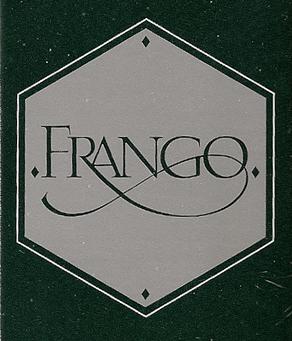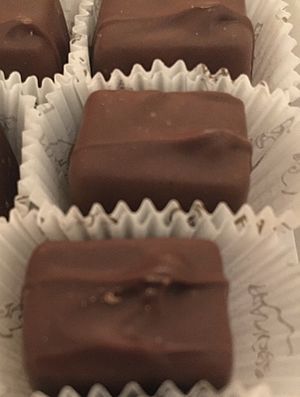Frango facts for kids

As a Marshall Field's licensee, Macy's created a Pacific Northwest version of the Frango logo still used today across the country.
|
|

A close-up of Frango mints, in packaging
|
|
| Owner | Garrett Popcorn Shops |
|---|---|
| Introduced | 1918 |
| Previous owners | Frederick & Nelson |
| Website | Frango Chocolate on Garrett |
Frango mints are a famous brand of chocolate truffles. They were first made for the Frederick & Nelson department stores. These tasty treats are known for their cool mint flavor. They became very popular thanks to the Marshall Field and Company department store. Later, Macy's department stores made and sold them. Frango is also a brand name for other yummy food products.
These candies are well-known in the Midwest and Pacific Northwest parts of the United States. You can find them in many stores across the country today. Frangos were created in Seattle, Washington, by the Frederick & Nelson department store in 1918. Later, a store in Chicago called Marshall Field's bought the company and the Frango name. Marshall Field's then introduced its own recipe in 1929. For 70 years, Frango mints were made in big melting pots on the 13th floor of the main Marshall Field's store.
In early 2017, Garrett Popcorn Shops bought the rights to sell Frango mints from Macy's. Macy's still sells its own version. But Garrett Popcorn Shops wants to make the chocolate brand even bigger. They also want to keep its long history and traditions alive. Today, Garrett Popcorn Shops makes, sells, and gives out Frango chocolate with a fresh new look. You can find them in their stores and online.
Contents
Where Did Frango Mints Come From?
The story of Frango mints began in 1918. At first, "Frango" was the name of a frozen dessert. This dessert was sold at the fancy Tea Room in Frederick & Nelson's department store in Seattle. The first Frango frozen dessert came in maple and orange flavors.
There are a few ideas about how the name "Frango" started.
- One idea is that it comes from "Fr" in Frederick’s and "ango" from the word tango.
- Another idea is that employees were taught it stood for FRederick And Nelson COmpany. The "C" was changed to a "G" because "Franco" sounded too much like something else.
- Some also say Frango is a mix of words: FRederick And Nelson GOodness.
A popular story says that the chocolates were first called Franco Mints. This story claims the name changed to Frango mints in the 1930s. This was after the Spanish Civil War, to avoid sounding like a certain Spanish leader. However, Frederick & Nelson had already registered "Frango" as a trademark in 1918. This means the name was Frango from the start.
In 1926, the Frango Dessert was described as flaky. You needed a fork to eat it, not a spoon like ice cream. The Frango name later included ice-cream sodas, pies, and milkshakes. It wasn't until 1927 that Ray Alden created the Frango mint meltaway chocolate. He was in charge of Frederick's candy kitchen. Alden's secret recipe used chocolate from African and South American cocoa beans. It also used triple-distilled oil of Oregon peppermint and lots of local butter.
Two Kinds of Frango Mints
In 1929, Marshall Field's decided to buy Frederick & Nelson's. Soon after, the candy makers from Seattle went to Chicago. They introduced Frango mints to Marshall Field's. This was done to help sales during the Great Depression. The candy kitchen at Marshall Field's then made its own version of the Frango Chocolate recipe.
The Northwest version still uses the original Frederick & Nelson recipe. But the Marshall Field's recipe has been changed a few times. Also, different ingredients and equipment are used. This explains any difference in taste between the two versions.
Different Packaging for Frango Mints
There is a key difference in how the two types of Frango chocolates are packaged.
- Midwestern Frango chocolates come in flat, traditional candy boxes. The chocolates are placed in paper cups.
- Northwest Frango chocolates are wrapped individually. They are sold in unique hexagon-shaped boxes.
Changes in Seattle
Frederick & Nelson Closes
For many years, Marshall Field's owned the Frederick & Nelson stores. Field's kept the Frederick & Nelson name and its local feel. But in 1982, Marshall Field's was bought by a company called BATUS Retail Group. This was not good for Frederick & Nelson. By 1986, BATUS sold Frederick & Nelson to a group of investors in Washington state. Even with these changes, Frederick's still sold Frangos. They had a special agreement with Field's. In 1992, Frederick's stores closed for good because of money problems.
By then, Field's had also changed owners. It became part of Dayton Hudson Corporation. Seattle leaders quickly made a deal. Dayton Hudson agreed to let Seattle's main department store, The Bon Marché, keep selling Frangos in the Northwest.
Seattle Gourmet Foods Steps In
This new plan had problems. When Frederick & Nelson was open, the candies were made on the 10th floor of their main store. After Frederick & Nelson closed, a former Frango candy maker started a company called Seattle Gourmet Foods. This company won a contract to make the candies for The Bon Marché. They moved the candy making to a new place. Seattle Gourmet used much of the same equipment Frederick & Nelson used to make the mints.
The Bon Marché and Macy's
After using Seattle Gourmet Foods for ten years, The Bon Marché ended their contract in 2003. Seattle Gourmet Foods then started making their own "Frederick & Nelson Fine Chocolates." They used hexagon-shaped boxes, just like the traditional Frangos. The Bon Marché sued them. But Seattle Gourmet Foods sued back, saying the contract was ended unfairly. In late 2004, they reached an agreement. The Bon Marché paid Seattle Gourmet Foods some money. In return, The Bon Marché got the only rights to the recipe, the hexagon boxes, and the Frederick & Nelson names.
Today, the Pacific Northwest version of Frango Chocolates is sold at Macy's Northwest stores. These are in Washington, Idaho, Montana, and Oregon. This happened because Federated Department Stores changed all its regional stores to the single Macy's name. Another local Seattle company, Seattle Chocolates, now makes the Frango chocolates for Macy's Northwest.
Changes in Chicago
Marshall Field's Candy Kitchen Closes
The Midwest version of Frangos was made on the 13th floor of the Marshall Field's main State Street store. This went on from 1929 until March 1999. However, there was too much demand for the chocolates for the in-store factory to handle. So, the owner at the time, Dayton-Hudson Corp., gave the job of making Frangos to Gertrude Hawk Chocolates in Dunmore, Pennsylvania. They closed the Field's candy kitchen and let go almost all the employees. This made many people in Chicago angry, especially Chicago Mayor Richard M. Daley. He wanted the famous chocolates to be made by a local Chicago company.
How Gertrude Hawk Makes Frangos
The process starts with huge blocks of Blommer chocolate from Chicago. This chocolate is melted at almost 200°F (93°C). Small rectangle molds get a mix of milk and dark chocolate, plus a special mint oil. This mixture is tempered to 83°F (28°C). The molds are shaken to remove any air bubbles. The chocolates then travel through a long, cold tunnel to cool down. Next, they go through an enrobing machine. Here, more chocolate is poured over them. The Frango mints are cooled again. Then, they are put into boxes by hand, sealed, wrapped, and prepared for shipping.
From Marshall Field's to Macy's
In 2004, Marshall Field's and the Frango name were bought by May Department Store Company. The May stores did not want Macy's to keep selling Frangos. So, Macy's Northwest changed the name of their Frangos to "Frederick & Nelson, the Original" in February 2005.
On August 30, 2005, Macy's owner, Federated Department Stores, bought the May Stores. This meant Macy's Northwest no longer needed a special agreement to use the Frango name. This brought the two types of Frango mints back together for the first time in 20 years. Macy's Northwest quickly changed the name of their mints back to "Frango."
Could Frangos Return to Chicago?
Many former Marshall Field's customers and Chicago Mayor Daley were very upset. Because of their protests, Federated chairman Terry J. Lundgren said in September 2005 that Macy's would look into moving production back to Chicago. He said Macy's would check their agreements to see if the chocolate could be made in Chicago again. However, Lundgren also said he wasn't promising anything.
Sales of Macy's-branded Frangos were much lower than when they were Marshall Field's Frangos. Many people in Chicago were upset that Marshall Field's stores became Macy's. They felt it was a step down for a famous Chicago store. Critics even asked people to stop shopping at Macy's.
In July 2009, Macy's announced that a Chicago candy maker, Cupid Candies, would start making one-pound boxes of Frango mint chocolates. Cupid Candies is an old Chicago company. These Frango mints would be sent to Macy's stores in the Chicago area. Other Frango candies and cookies would still be made by Gertrude Hawk Chocolates in Pennsylvania.
State Street Viewing Kitchen Reopens
Around the same time as the Cupid Candies deal, the Frango Viewing Kitchen reopened. It is on the seventh floor of Macy's On State Street in Chicago. This kitchen had closed in 1999 when Frango production moved to Pennsylvania. Now, visitors to the store can watch the enrobing process. This is where the Frango chocolate centers are covered in chocolate to make the outside layer. These chocolates are then used for samples.
Frango Products at Macy's
By 2006, the Midwest version of Frango chocolates and other items were sold online on the Macy's website. In the stores that used to be Bon Marché, Macy's sells the Northwest version of the chocolates. The Midwest version is sold in other parts of the country.
In the Northwest, Frango chocolates come in many flavors. New seasonal flavors are added throughout the year. During Christmas, Macy's Northwest sells a stuffed Frango teddy bear and other gift sets. In 2006, gift sets with a Frango mug, drinking chocolate, cookies, and a box of Frango chocolates were sold.
Macy's North continues the Marshall Field's tradition by selling the full line of Frango products. Besides the classic mint Frangos, they sell chocolates with other flavors, special edition Frangos, coffee, hot chocolate, truffles, cookies, and liqueurs. In 2006, Macy's announced that Eli's Cheesecake, a famous Chicago cheesecake maker, would again make Frango cheesecake. Eli's had made Frango mint cheesecakes for Marshall Field's in the 1980s.
The Frango Café is also on the seventh floor of Macy's on State Street. It offers sandwiches and salads, along with other sweet treats.
Garrett's Frango Mints
In 2017, Garrett Popcorn Shops, a popular Chicago popcorn company, bought the rights to the Marshall Field's recipe for Frango mints. Garrett's goal for Frango is still developing. However, some pop-up stores around Chicago have sold Frango chocolates using the "Creamy and minty" Marshall Field's recipe. This recipe had been missed in Chicago for a long time. The chocolate is also made in Elgin, Illinois, north of Chicago. Stores have been seen in Rosemont, O'Hare Airport, Water Tower Place, Navy Pier, and Northbridge Mall. All these locations have since closed.
Images for kids


